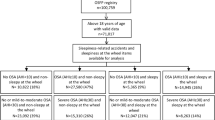Abstract
Purpose
Obstructive sleep apnoea (OSA) patients effectively treated by and compliant with continuous positive air pressure (CPAP) occasionally miss a night’s treatment. The purpose of this study was to use a real car interactive driving simulator to assess the effects of such an occurrence on the next day’s driving, including the extent to which these drivers are aware of increased sleepiness.
Methods
Eleven long-term compliant CPAP-treated 50–75-year-old male OSA participants completed a 2-h afternoon, simulated, realistic monotonous drive in an instrumented car, twice, following one night: (1) normal sleep with CPAP and (2) nil CPAP. Drifting out of road lane (‘incidents’), subjective sleepiness every 200 s and continuous electroencephalogram (EEG) activities indicative of sleepiness and compensatory effort were monitored.
Results
Withdrawal of CPAP markedly increased sleep disturbance and led to significantly more incidents, a shorter ‘safe’ driving duration, increased alpha and theta EEG power and greater subjective sleepiness. However, increased EEG beta activity indicated that more compensatory effort was being applied. Importantly, under both conditions, there was a highly significant correlation between subjective and EEG measures of sleepiness, to the extent that participants were well aware of the effects of nil CPAP.
Conclusions
Patients should be aware that compliance with treatment every night is crucial for safe driving.






Similar content being viewed by others
References
George C (2001) Reduction in motor vehicle collisions following treatment of sleep apnoea with nasal CPAP. Thorax 56:508–512
Grunstein RR, Stewart DA, Lloyd H, Akinci M, Cheng N, Sullivan CE (1996) Acute withdrawal of nasal CPAP in obstructive sleep apnea does not cause a rise in stress hormones. Sleep 19(10):774–782
Yang Q, Phillips CL, Melehan KL, Rogers NL, Seale JP, Grunstein RR (2006) Effects of short-term CPAP withdrawal on neurobehavioral performance in patients with obstructive sleep apnea. Sleep 29(4):545–552
Turkington PM, Sircar M, Saralaya D, Elliott MW (2004) Time course of changes in driving simulator performance with and without treatment in patients with sleep apnoea hypopnoea syndrome. Thorax 59(1):56–59
Horne JA, Reyner LA (1995) Sleep related vehicle accidents. BMJ 310(6979):565–567
Horne JA, Reyner LA (1999) Vehicle accidents related to sleep: a review. BMJ 56(5):289–294
Kribbs NB, Pack AI, Kline LR, Getsy JE, Schuett JS, Henry JN, Maislin G, Dinges DF (1993) Effects of one night without nasal CPAP treatment on sleep and sleepiness in patients with obstructive sleep apnea. Am Rev Resp Dis 147(5):1162–1168
Sforza E, Lugaresi E (1995) Daytime sleepiness and nasal continuous positive airway pressure therapy in obstructive sleep apnea syndrome patients: effects of chronic treatment and 1-night therapy withdrawal. Sleep 18(3):195–201
Engleman HM, Hirst WS, Douglas NJ (1997) Under reporting of sleepiness and driving impairment in patients with sleep apnoea/hypopnoea syndrome. J Sleep Res 6:272–275
Johns MW (1991) A new method for measuring daytime sleepiness: the Epworth Sleepiness Scale. Sleep 14:540–546
Filtness AJ, Reyner LA, Horne JA (2011) Moderate sleep restriction in treated older male OSA participants: Greater impairment during monotonous driving compared with controls. Sleep Med, doi:10.1016/j.sleep.2011.07.002
Ǻkerstedt T, Gillberg M (1990) Subjective and objective sleepiness in the active individual. Int J Neurosci 52:29–37
Kecklund G, Åkerstedt T (1993) Sleepiness in long distance truck driving: an ambulatory EEG study of night driving. Ergonomics 36:1007–1017
Eoh H, Chung M, Kim S (2005) Electroencephalographic study of drowsiness in simulated driving with sleep deprivation. Int J Ind Ergon 35:307–320
Greneche J, Krieger J, Erhardt C, Bonnefond A, Eschenlauer A, Muzet A, Tassi P (2008) EEG spectral power and sleepiness during 24 h of sustained wakefulness in patients with obstructive sleep apnea syndrome. Clin Neurophysiol 119:418–428
Tassi P, Grenčche J, Pebayle T, Eschenlauer A, Hoeft A, Bonnefond A, Rohmer O, Muzet A (2008) Are OSAS patients impaired in their driving ability on a circuit with medium traffic density? Accid Anal Prev 40:1365–1370
Jap B, Lal S, Fischer P, Bekiaris E (2009) Using EEG spectral components to assess algorithms for detecting fatigue. Expert Syst Appl 36:2352–2359
Horne J, Reyner L (1996) Counteracting driver sleepiness: effects of napping, caffeine, and placebo. Psychophysiology 33:306–309
Reyner LA, Horne JA (1998) Falling asleep at the wheel: are drivers aware of prior sleepiness? Int J Legal Med 111:120–123
Horne JA, Baulk SD (2003) Awareness of sleepiness when driving. Psychophysiology 41:161–165
Philip P, Sagaspe P, Taillard J, Valtat C, Moore N, Akerstedt T, Charles A, Bioulac B (2005) Fatigue, sleepiness, and performance in simulated versus real driving conditions. Sleep 28:1511–1516
Acknowledgements
We wish to thank all of the participants and the Leicester Sleep Apnoea Patients Association for their co-operation with recruitment, additionally Dr. Chris Hanning and Dr. Andrew Hall from Leicester General Hospital Sleep Disorders Services, University Hospitals of Leicester NHS Trust, for their continued support.
Conflict of interest
The authors declare that they have no conflict of interest.
Author information
Authors and Affiliations
Corresponding author
Rights and permissions
About this article
Cite this article
Filtness, A.J., Reyner, L.A. & Horne, J.A. One night’s CPAP withdrawal in otherwise compliant OSA patients: marked driving impairment but good awareness of increased sleepiness. Sleep Breath 16, 865–871 (2012). https://doi.org/10.1007/s11325-011-0588-8
Received:
Revised:
Accepted:
Published:
Issue Date:
DOI: https://doi.org/10.1007/s11325-011-0588-8




